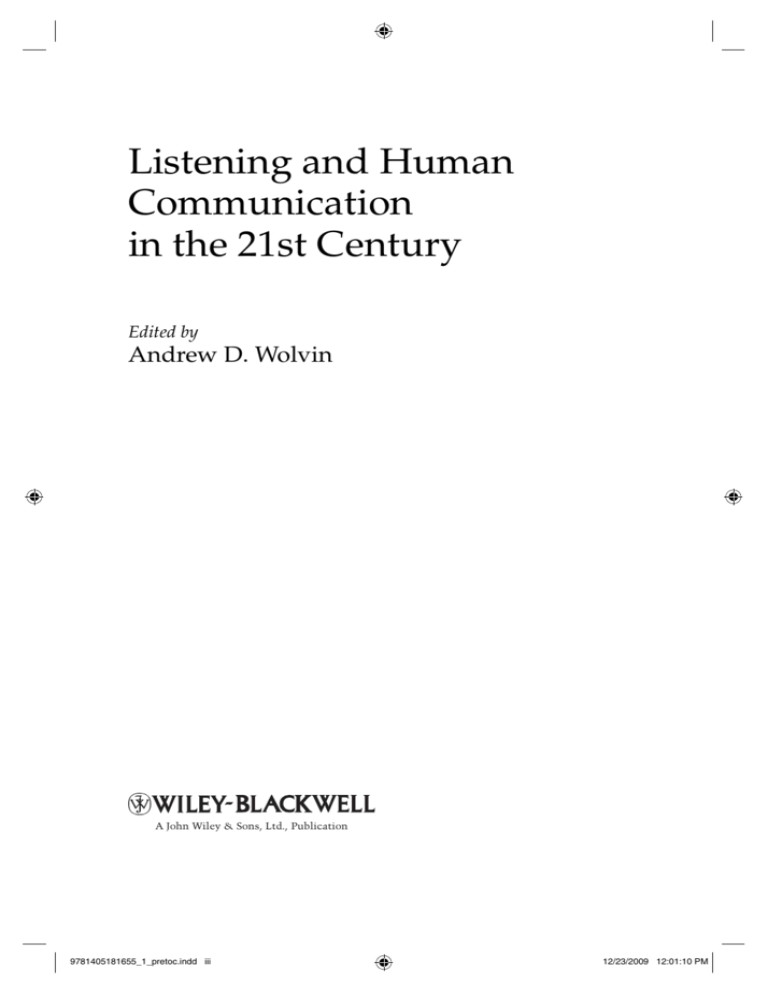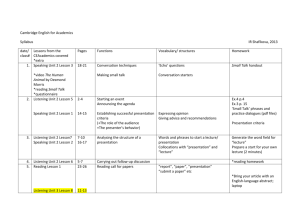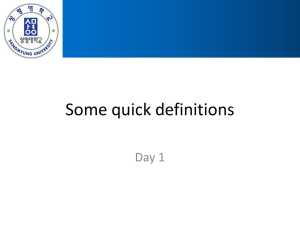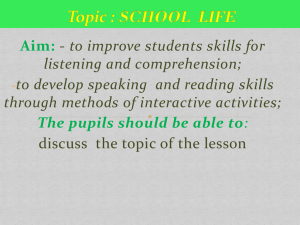
Listening and Human
Communication
in the 21st Century
Edited by
Andrew D. Wolvin
A John Wiley & Sons, Ltd., Publication
9781405181655_1_pretoc.indd iii
12/23/2009 12:01:10 PM
9781405181655_1_pretoc.indd ii
12/23/2009 12:01:10 PM
Listening and Human Communication
in the 21st Century
9781405181655_1_pretoc.indd i
12/23/2009 12:01:10 PM
9781405181655_1_pretoc.indd ii
12/23/2009 12:01:10 PM
Listening and Human
Communication
in the 21st Century
Edited by
Andrew D. Wolvin
A John Wiley & Sons, Ltd., Publication
9781405181655_1_pretoc.indd iii
12/23/2009 12:01:10 PM
This edition first published 2010
© 2010 Blackwell Publishing Ltd
Blackwell Publishing was acquired by John Wiley & Sons in February 2007. Blackwell’s
publishing program has been merged with Wiley’s global Scientific, Technical, and
Medical business to form Wiley-Blackwell.
Registered Office
John Wiley & Sons Ltd, The Atrium, Southern Gate, Chichester, West Sussex, PO19 8SQ,
United Kingdom
Editorial Offices
350 Main Street, Malden, MA 02148-5020, USA
9600 Garsington Road, Oxford, OX4 2DQ, UK
The Atrium, Southern Gate, Chichester, West Sussex, PO19 8SQ, UK
For details of our global editorial offices, for customer services, and for information
about how to apply for permission to reuse the copyright material in this book please
see our website at www.wiley.com/wiley-blackwell.
The right of Andrew D. Wolvin to be identified as the author of the editorial material in
this work has been asserted in accordance with the Copyright, Designs and Patents Act
1988.
All rights reserved. No part of this publication may be reproduced, stored in a retrieval
system, or transmitted, in any form or by any means, electronic, mechanical, photocopying, recording or otherwise, except as permitted by the UK Copyright, Designs and
Patents Act 1988, without the prior permission of the publisher.
Wiley also publishes its books in a variety of electronic formats. Some content that
appears in print may not be available in electronic books.
Designations used by companies to distinguish their products are often claimed as
trademarks. All brand names and product names used in this book are trade names,
service marks, trademarks or registered trademarks of their respective owners. The
publisher is not associated with any product or vendor mentioned in this book. This
publication is designed to provide accurate and authoritative information in regard to
the subject matter covered. It is sold on the understanding that the publisher is not
engaged in rendering professional services. If professional advice or other expert
assistance is required, the services of a competent professional should be sought.
Library of Congress Cataloging-in-Publication Data
Listening and human communication in the 21st century/edited by Andrew D. Wolvin.
p. cm.
Includes bibliographical references and index.
ISBN 978-1-4051-8165-5 (hardcover : alk. paper) — ISBN 978-1-4051-8164-8 (pbk. : alk.
paper)
1. Listening—Textbooks. 2. Communication—Textbooks. I. Wolvin, Andrew D.
P95.46.L55 2009
302.2′44—dc22
2009015235
A catalogue record for this book is available from the British Library.
Set in 10/13pt Palatino by SPi Publisher Services, Pondicherry, India
Printed in Malaysia
1
2010
9781405181655_1_pretoc.indd iv
12/23/2009 12:01:10 PM
Contents
List of Figures
List of Tables
Notes on Contributors
vii
viii
ix
Introduction: Perspectives on Listening in the 21st Century
Andrew D. Wolvin
1
Part I
5
Theoretical Overview of Listening
1 Listening Engagement: Intersecting Theoretical Perspectives
Andrew D. Wolvin
Part II
Listening Research Methods
2 Qualitative Research: Critical for Understanding Listening
Michael W. Purdy
7
31
33
3 Quantitative Research in Listening: Explication
and Overview
Graham D. Bodie and Margaret Fitch-Hauser
46
Part III
95
Listening as a Cognitive and Relational Activity
4 What is Going on in the Mind of a Listener?
The Cognitive Psychology of Listening
Margarete Imhof
97
5 Listening: A Dialogic Perspective
James J. Floyd
127
6 The Skills of Listening-Centered Communication
Judi Brownell
141
9781405181655_2_toc.indd v
12/23/2009 12:01:37 PM
vi
Contents
7 Listening in a Second Language
John Flowerdew and Lindsay Miller
Part IV
Listening in Contexts
158
179
8 Listening Practices: Are We Getting Any Better?
Sheila C. Bentley
181
9 Listening Pedagogy: Where Do We Go from Here?
Laura A. Janusik
193
10 Perspectives on Intercultural Listening
Melissa L. Beall
225
11 Listening in Spirituality and Religion
Diana Corley Schnapp
239
12 The Integrative Listening Model: An Approach
to Teaching and Learning Listening
Kathleen Thompson, Pamela Leintz, Barbara
Nevers and Susan Witkowski
Index
9781405181655_2_toc.indd vi
266
287
12/23/2009 12:01:37 PM
Figures
Figure 3.1
Figure 3.2
Figure 4.1
Figure 4.2
Figure 6.1
Figure 6.2
Figure 6.3
Figure 9.1
Figure 10.1
Figure 12.1
Figure 12.2
Figure 12.3
9781405181655_3_posttoc.indd vii
Scatterplot representing a correlation of .50
between listening comprehension and GPA
OLS regression line representing the “best fit”
between listening comprehension and GPA
for a correlation approximating .50
Model of listening in terms of cognitive
psychology
Mindmap of variables pertaining
to a comprehensive model of listening
The HURIER Listening Model
The listening assessment cycle
The HURIER Listening Model:
Situational demands
The listening quad
The word “to listen” in Chinese
The Integrative Listening Model
Listening criteria matrix
ILM Listening Process Model
57
58
99
110
145
149
151
211
233
269
270
274
12/23/2009 12:01:30 PM
Tables
Table 11.1
References to hearing and listening
in two versions of The Holy Bible
Table 12.1 Listening process components
9781405181655_3_posttoc.indd viii
244
275
12/23/2009 12:01:30 PM
Notes on Contributors
Melissa L. Beall is a professor of Communication Studies at the
University of Northern Iowa, Cedar Falls, Iowa. Dr Beall teaches a variety of classes including: Listening, Oral Communication, Critical
Thinking in Communication, Intercultural Communication, Introduction
to Graduate Study and Research, Communication Theories, Message
Design and Delivery, Senior Seminar, Instructional Communication,
and Communication and Technology.
Sheila C. Bentley of Bentley Consulting resides outside of Memphis,
TN, and has been a communication consultant for 24 years. With clients
nationwide, she works with FedEx, Nike, Disney, the US Army, Hilton
Hotels, and numerous education institutions. She has also served as
adjunct faculty at the University of Memphis and Arizona State
University. Her focus in listening has been in business applications –
how to use listening skills to bring about a positive impact on the business, whether as a financial return or improved relations with employees
and customers.
Graham Bodie is an Assistant Professor in the Department of
Communication Studies at The Louisiana State University. He is
devoted to the study of listening and information processing in context
and has published in outlets such as Communication Yearbook, Health
Marketing Quarterly, and The International Journal of Listening.
Judi Brownell is a Professor and Dean of Students in the School of Hotel
Administration at Cornell University. She is also a past president of the
International Listening Association. She has authored several listening
textbooks, her most recent being Listening: Attitudes, Principles, and Skills,
9781405181655_3_posttoc.indd ix
12/23/2009 12:01:30 PM
x
Notes on Contributors
and over 30 articles on managerial listening behavior. She has applied
her HURIER model of the listening process to a wide variety of hospitality contexts including the hotel, casino, club, and cruise industries.
Diana Corley Schnapp has taught Speech Communication courses,
including Listening, in secondary school, community colleges, and universities for 35 years. A former Executive Director of the International
Listening Association, she has published articles about listening in academic journals, popular magazines, and religious publications. Most
recently a Communications Adjunct Professor at Rockhurst University
in Kansas City, Missouri, she has been a consultant in communication
for government organizations, private business, non-profit organizations, and faith communities. She has written and taught religious studies for over 40 years.
Margaret Fitch-Hauser is an Associate Professor and Chair of the
Department of Communication and Journalism at Auburn University.
She has engaged in listening research for 30 years and has presented to
all but one ILA conference. Her current research focuses on listening
fidelity and cross-cultural elements of listening.
John Flowerdew is a Professor of Applied Linguistics in the Department
of English at City University of Hong Kong. He has published extensively in the areas of discourse analysis, pragmatics, listening, and corpus linguistics. He is co-author with Lindsay Miller of Second Language
Listening: Theory and Practice.
James J. Floyd is a Professor of Communication at the University of
Central Missouri. He is currently editor of The International Journal of
Listening.
Margarete Imhof is Professor for Educational Psychology in the teacher
education program at the Johannes Gutenberg University in Mainz,
Germany. She has been working on the psychology of attention and listening for many years. Her area of interest is to investigate listening as a mental process and research on how listening skills can be learned and taught.
Laura A. Janusik is an Assistant Professor and the McGee Chair of
Communication at Rockhurst University in Kansas City, Missouri.
She considers herself a listening cognitivist, and has designed the
9781405181655_3_posttoc.indd x
12/23/2009 12:01:30 PM
Notes on Contributors xi
Conversational Listening Span, an instrument to measure one’s conversational listening capacity. Her work can be found in The
International Journal of Listening, Communication Studies, and the Journal
of Intercultural Communication Research.
Pamela Leintz, former Staff Assesor at Alverno College, has taught,
assessed, and worked on curriculum design. She is currently on staff at
the Georgia State University School of Music.
Lindsay Miller is an Associate Professor of Applied Linguistics in the
Department of English at City University of Hong Kong. He has published widely in the areas of teacher education, listening and learner
autonomy. He is co-author with John Flowerdew of Second Language
Listening: Theory and Practice.
Barbara Nevers, Assistant Professor in Liberal Studies at Alverno College,
teaches the first semester communication seminar and Integrating
Learning, a course developing students’ proficiency in the eight Alverno
abilities.
Michael W. Purdy is a Professor in the Communications Program at
Governors State University (Illinois), University Park. His academic
work has focused on the study and teaching of listening, as well as
broader concerns of dialogic communication. With Deborah Borisoff,
he has authored Listening in Everyday Life: A Personal and Professional
Approach. He has also authored articles and book chapters on listening,
research, and communication philosophy.
Kathleen Thompson is a Professor in the Professional Communication
Department at Alverno College. She chairs the Listening Task Group,
which coordinates the teaching and assessing of listening across
Alverno’s ability-based curriculum. A member and former Executive
Director of the International Listening Association (ILA), she received
ILA’s Outstanding Teacher of the Year and the Hall of Fame Award for
notable achievements involving listening in academic, business, and
other settings.
Susan Witkowski is Assistant Director of Instructional Services at
Alverno College, develops language programs and provides teacher
training, in addition to teaching communication courses.
9781405181655_3_posttoc.indd xi
12/23/2009 12:01:30 PM
xii
Notes on Contributors
Andrew D. Wolvin is a Professor in the Department of Communication
at the University of Maryland, College Park. His academic career has
been devoted to the study and teaching of listening. With Carolyn G.
Coakley, he has authored widely used books in listening including
Listening, Perspectives on Listening, Experiential Listening, and Listening in
the Quality Organization.
9781405181655_3_posttoc.indd xii
12/23/2009 12:01:31 PM
Introduction: Perspectives
on Listening in the 21st Century
Andrew D. Wolvin
Listening and Human Communication
in the 21st Century
The twenty-first century brings with it any number of challenges to the
world order. Nation states are in disarray as rulers make life-ending
decisions for thousands of followers. Natural resources are in limited
supply, and the fury of nature has threatened to bring devastation to
entire countries and regions throughout the world. The fragility of economic systems is revealed in major ways, impacting millions of people
who find it increasingly difficult to afford their present lifestyle. Human
medical advances cannot keep up with the mutations that continue to
bring down, or threaten to bring down, vast numbers.
Against the doom and disaster of today’s dysfunctional world, people
are embracing new ways to connect with each other through modernday technology, through religious organizations, and through renewed
attention to personal and professional relationships alike.
Never has it been so apparent that the world needs listeners. Leaders
need to listen to their followers to formulate policy and create programs
that will be responsive to the needs of their constituents. And people
need to listen to each other throughout the world to increase international understanding and bring a sense of order to world affairs.
Getting people to listen to each other, however, is not an easy objective. Unfortunately, listening has come to be viewed, at least in American
society, as a passive, simple act that we just do. The word “just” is all
too frequently used to describe listening in the admonition “Just listen.” This reduces listening, then, to the non-active, receptor, part of
human communication.
9781405181655_4_000.indd 1
12/23/2009 12:07:56 PM






